The S&W Model 500 revolver always looked like something Yosemite Sam would carry. The staggering, over-the-top handgun ballistics this cartridge produces have always fascinated me, but it’s a fascination I’ve been happy to indulge from a safe distance. The high price of .500 ammo and pistols (and the reputedly brutal recoil of the affordable H&R Handi-Rifle that also fires it) have kept me out of the .500 game. Until recently, that is . . .
The Model 89
Big Horn Armory’s Model 89 is based on John Moses Browning’s Winchester models of 1886 and 1892. It uses the same design and lockup as the old Winchesters, but falls between the two models in size. It’s made entirely of 17-4 stainless steel, and it’s available either in satin-finished stainless or ‘Hunter Black,’ a finish that resembles Glock’s proprietary Tenifer or SIG/Sauer’s Nitron finish, but smoother and shinier. Both Model 89 finishes are completely weatherproof, and both look completely awesome.
The Model 89 rifle’s half-length magazine tube holds five rounds of .500 S&W, which is more than you’ll ever need for any land animal roaming the planet. There’s a half-cock notch but no manual safety, and the trigger can’t be pulled unless the lever is fully closed and the bolt fully in battery. Many hunters carry their lever-actions with an empty chamber, and that would be a wise practice with the Big Horn Model 89. An empty chamber is safer than a half-cocked hammer, but just as fast to bring into action with a lever gun.
There’s a rear sling mount just forward of the toe of the buttstock, along with a snag-free front sling mount machined into the steel fore-end cap. The Model 89 is a powerful rifle that generates significant recoil, and a poorly designed front sling stud can take a chunk of flesh from the index finger of your support hand. I’ve done this myself and it hurts like hell; this is why dangerous-game rifles always mount their slings on a barrel band instead of the fore-end. This isn’t the only dangerous-game feature of the Model 89.
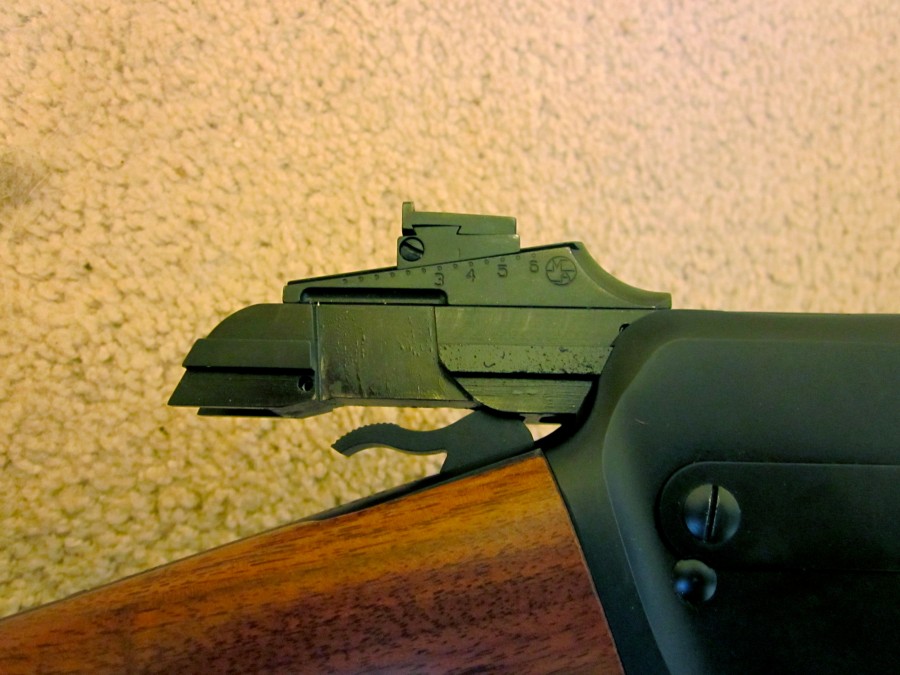 The rear sight is a large aperture peep sight, fully adjustable for windage and elevation. The aperture is so large that it almost qualifies as a ghost ring. It lacks some precision (particularly if you’re not blessed with good eyesight) but it’s perfect for low-light shooting and rapid target acquisition. This is particularly good if you’re hunting any of the dangerous critters that this rifle can anchor with a single shot.
The rear sight is a large aperture peep sight, fully adjustable for windage and elevation. The aperture is so large that it almost qualifies as a ghost ring. It lacks some precision (particularly if you’re not blessed with good eyesight) but it’s perfect for low-light shooting and rapid target acquisition. This is particularly good if you’re hunting any of the dangerous critters that this rifle can anchor with a single shot.
Unlike any other lever-action I’ve ever seen, the Model 89 has its rear sight attached to the bolt instead of the barrel or receiver. It’s an interesting design choice; I would have expected to see a Williams or Lyman receiver sight instead, but Big Horn’s design seems to work just fine.
Is it just me, or does that rear sight ramp look like it was borrowed from a Remington Model 700? The rear sight is fully adjustable, but that adjustment requires a careful hand on the (very small) screwdriver. When you loosen the locking screw the sight slides up and down the elevation ramp freely, so be sure to hold it in place and nudge it up or down just a bit. The index marks help, but only if you make a note of where the sight is set before you make the adjustment. Be sure to tighten the sight screw firmly once you’re done.
The front sight is a tall post with a brass bead for visibility, although an imitation ivory bead would have looked even cooler. The tall front and rear sights help with rapid acquisition, and they also mean you don’t have to scrunch your face down too close to the stock. You’ll like this when you’re shooting the heaviest .500 S&W loads, which are almost comparable to the recoil of a .375 H&H Magnum.

Our test gun was the Model 89 Rifle with a 22-inch barrel. If you need a handier gun and don’t mind sacrificing a few feet per second, the Model 89 Carbine version shown here wears a slightly shorter 18″ barrel.
Ballistics, or ‘Is This Really A Handgun Cartridge?’

I’ve never had the opportunity to touch off a .500 S&W cartridge in a handgun. Then again, I’ve never fired 12-guage 3″ rifled slugs out of a pistol either. I don’t believe I’m missing anything particularly pleasant in either caliber, since 12-guage slugs leave me punch-drunk after a dozen rounds or so from an 18″ shotgun, and the mighty .500 S&W delivers almost the same muzzle energy from an 8″ pistol. After the amazing results of our .357 Magnum pistol vs. lever-action carbine ballistics tests, I really wanted to know how much bigger a can of whoop-ass the .500 S&W would open up from a long-barreled rifle.
To that end, we spent a minor king’s ransom to purchase 80 rounds of .500 S&W ammo. Before the recent price panic, the same wad of cash ($180) would have delivered at least 800 rounds of 5.56 to my door, but that’s another story for another day. Half of the ammo were 400-grain Double Tap hard-cast lead flatpoints, and the rest were from HSM: gas-checked 440-grain lead flatpoints (called their “Bear Load”) and some very mild 300-grain plated hollowpoints.
According to our own chronograph tests, the heaviest bullet weight wasn’t the heaviest hitter. The 440-grain ‘Bear Loads’ averaged 1960 fps and 3753 lb-ft; they produced a long, rolling recoil which was firm but not too violent. The 300-grain plated HPs averaged 1510 fps and 1519 lb-ft, and they kicked less than a .45 Colt ‘cowboy’ load from a long-barreled Winchester rifle.
And then there were the 400-grain Double Taps. These monsters sizzled through the chrono traps at 2240 fps, producing a thundering 4,457 lb-ft. of muzzle energy and a Taylor KO factor of 64. This is more energy and a higher KO factor than the storied .404 Jeffery, and only 400 lb-ft. less than a .458 Winchester Magnum! These loads probably push the envelope when it comes to chamber pressure: the fired cases showed signs of primer cratering and flattening, and if I’d handloaded them I’d definitely want to back them down a few tenths of a grain to be on the safe side.
Recoil with the Double Taps was somewhere between a short-barreled 12-guage firing 3″ rifled slugs, and a bolt-action .375 H&H Magnum. Either way…ouch. The Model 89’s thick recoil pad does an excellent job of taming these beasts, at least when firing offhand.
I may never do it myself, but with short-range energy like this, the Model 89 certainly seems capable of bringing down just about anything that walks or crawls the Earth, including Africa’s ‘Big Five.’ If you can afford the travel costs and game management fees for an African safari, the price of the Model 89 and .500 S&W ammo certainly won’t bother you.
Fit And Finish
As befits a $2,500 custom rifle, the Model 89 exhibits extremely good fit and finish in every detail. Visible surfaces are completely free of blemishes or toolmarks, and all parts fit together with what feels like hand-fit precision.
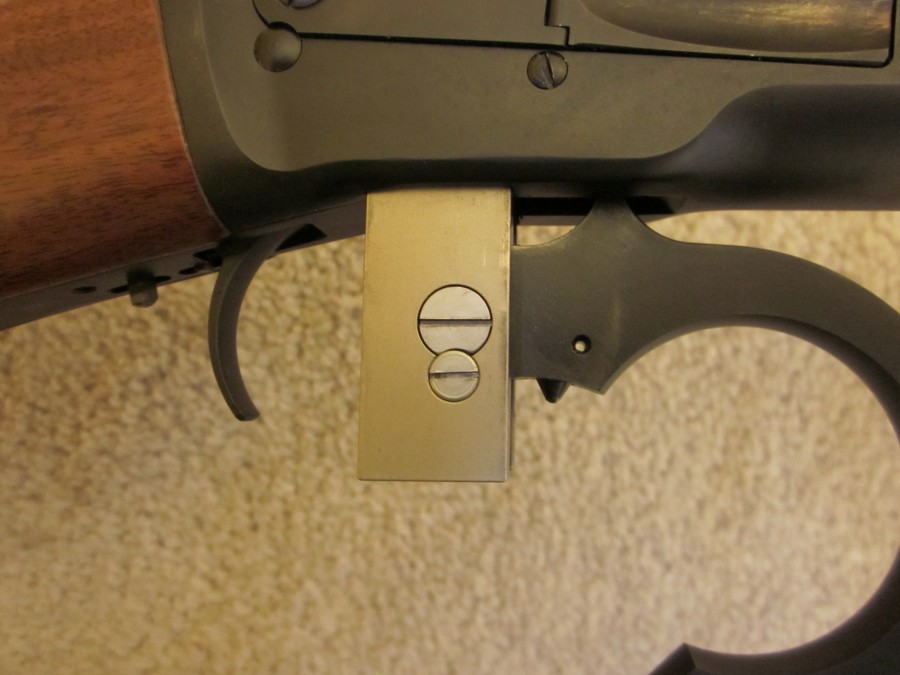 Double-set action screws like these are a classy touch, straight from the sidelocks of a bespoke English double rifle. Despite being categorized as ‘#2 Walnut’, the stock is simply gorgeous. The wood has a three-dimensional luster that’s nearly impossible to capture in still photos, but somehow Big Horn’s #1 Walnut stocks are even fancier.
Double-set action screws like these are a classy touch, straight from the sidelocks of a bespoke English double rifle. Despite being categorized as ‘#2 Walnut’, the stock is simply gorgeous. The wood has a three-dimensional luster that’s nearly impossible to capture in still photos, but somehow Big Horn’s #1 Walnut stocks are even fancier.
Excellent, But Not Quite Perfect
There is but one aspect of fit, finish or function where the Model 89 merits any real criticism: the lever. It’s unnecessarily stiff to open, because the surfaces of the bolt and hammer are machined a bit too precisely. The sharp-edged bottom rear of the bolt has the job of cocking the hammer (above) and this action would be noticeably easier if these edges were polished and gently radiused. This is a cowboy race-gun trick, and it works wonders on almost any J.M. Browning design.
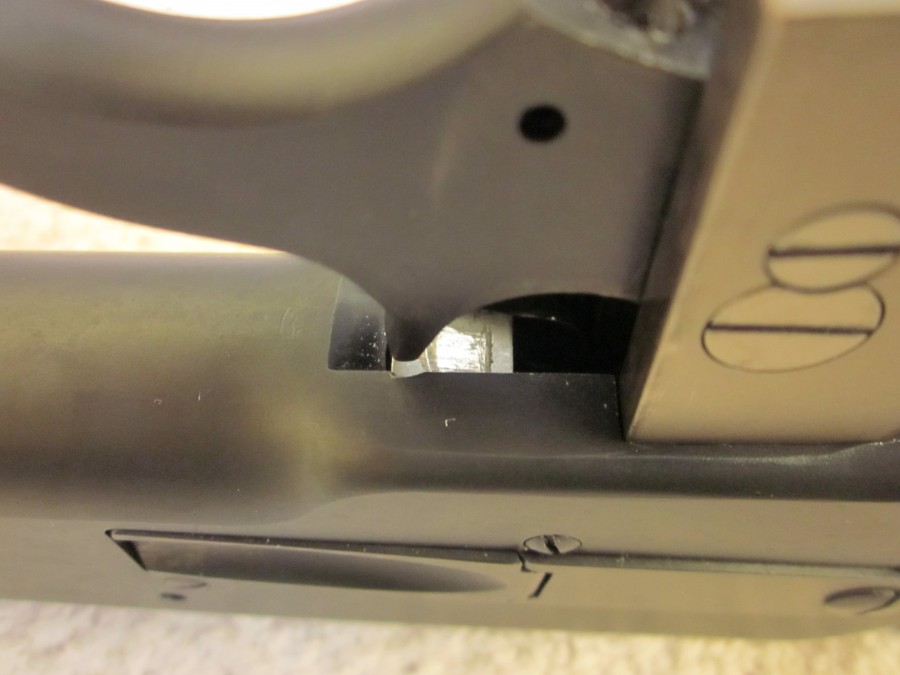 The lever is also more difficult to work as you open it the last inch or so, as it engages the shell lifter. This photo shows the culprit. As you open the lever, the lever prong pushes upward (or downward, in this photo) against the white-metal bottom of the shell lifter. The bottom of this shell lifter has developed a serious gouge where the lever strikes it, and it takes a bit of extra effort to force the lever over the gouge and raise the lifter fully. Once you’re past this point, chambering the round and closing the action is smooth and easy.
The lever is also more difficult to work as you open it the last inch or so, as it engages the shell lifter. This photo shows the culprit. As you open the lever, the lever prong pushes upward (or downward, in this photo) against the white-metal bottom of the shell lifter. The bottom of this shell lifter has developed a serious gouge where the lever strikes it, and it takes a bit of extra effort to force the lever over the gouge and raise the lifter fully. Once you’re past this point, chambering the round and closing the action is smooth and easy.
This gouge looks like simple wear instead of a machining defect, and it would be an easy fix if I weren’t intimidated by the prospect of detail-stripping a Winchester lever gun. I’m pretty sure I could dress this surface with a polishing stone and make this lever much easier to cycle, but I don’t play gunsmith on somebody else’s guns.It’s a point of pride that I’ve never returned a test gun in pieces.
Reliability
The Model 89 functioned perfectly when we stuck to the heavy cast bullets. The magazine loading gate is a bit of a finger-biter, but that issue is common to almost all gate-fed lever guns. (Many detachable box magazines are also difficult to load, but that doesn’t detract from the utility or reliability of the gun.) By the time we’d shot up all the ammo we’d pretty much mastered the loading technique anyway.
The lightweight 300-grain plated hollowpoints gave us fits when trying to stuff them into the magazine. They sometimes hung up just before sliding fully into the magazine tube, and usually needed to be pried and wiggled to coax them in the last few millimeters. When firing the rifle, these light loads didn’t guide themselves smoothly into the chamber. They often needed an extra jiggle of the lever before it closed. I mentioned this to Big Horn president Greg Buchel, and he correctly noted that lever-actions are sensitive to bullet length and profile. The Model 89, he said, was intentionally designed for best performance with the heaviest bullets.
The heaviest bullets in this caliber are hard-cast lead bullets, shaped like slightly-streamlined soda cans with almost no ogive (conical nose) at all. Just like many 1911s prefer round-nose bullets to semi-wadcutters, the Model 89 prefers these long, nearly-cylindrical bullets to shorter round-nose bullets. These heavy bullets fed more easily into the magazine tube, and chambered with minimal effort.
Ejection was always flawless, with empty cases consistently flipping upward from the action and landing a few feet to the side.
One handling note must be mentioned: the Model 89 will not feed properly if the rifle is canted 90 degrees to the side. Like all open-topped lever actions, the next live round can fall out of the open action if you tilt it over too far. The shell lifter depends on gravity to hold the shell in place while it’s lifted to the chamber, so you won’t see Master Chief carrying a Model 89 in microgravity.
Accuracy
Truth be told, we didn’t spend a lot of time bench-resting the Model 89. Other gunwriters have reported 2-3 MOA accuracy; pretty impressive results, considering the Model 89’s ghost-ring sights and rollicking recoil. We spent the first 15 rounds (of our precious 80 rounds) shooting over the chronograph screens and evaluating recoil.
Shooting at 50 yards from an improvised bench (in a blinding snowstorm) the 400-grain Double Taps were giving us 3″-4″ groups. We didn’t get impressive groups on paper with these monstrously powerful loads, but again, conditions were absolutely horrible.
We had so much fun blowing stuff up with the 400-grain dinosaur-killers that we forgot to save any of them for more careful accuracy testing. We saved about 15 rounds each of the 300-grain and 440-grain loads, and their performance vindicated the Model 89’s accuracy.
The 300-grain loads averaged 1.4 inches at 50 yards, and the 440-grain loads averaged 1.2 inches at 50 yards.
The 440-grain HSMs produced 3″ groups at 100 yards, but I ran out of the 300-grain plated hollowpoints before I got to the 100-yard range. I’m not a terribly good shot with iron sights at 100 yards, and I’m frankly surprised that I shot this well with the Model 89’s ghost-ring sights.
I’m certain this gun can shoot more precisely with a low-magnification scout scope, but the extra bulk and weight might not be worth it. The nearly-cylindrical bullets are ballistically inefficient, and they shed their energy and drop like footballs at ranges beyond 200 yards.
Blowing Stuff Up
Farago gave me just one command before shipping this gun to my FFL guy: shoot lots of watermelons. Roger that.
But Wait, There’s More!
And now in slow-motion!
One of our non-exploding targets was a 10″ stack of packed dry law books. Wet newsprint is a low-cost ballistic medium which crudely simulates animal tissue, and Big Horn president Greg Buchel advised me that heavy loads were getting 15″ to 18″ of penetration through it. This 10-inch stack of newsprint was all I had to work with, so we decided to see how the .500 did on packed dry newsprint instead.
The Double Tap loads drove their 400-grain dinosaur killers all the way through five inches of this incredibly tough ballistic medium, which tends to disintegrate bullets in the first inch after impact. The first 2.5″ thick book had a half-inch entrance wound and a thumb-sized exit hole. The second 2.5″ thick book had a huge entrance hole in the front and a torn bulge in the back cover, from which large lead fragments protruded slightly into the third book.
The Coolest Thing About This Gun:
The coolest thing about the Big Horn Armory Model 89 is that it’s so damn powerful yet still so fun and easy to shoot. Whether you’re hunting Kodiak browns or just blasting tree stumps into geysers of wood pulp, the .500 S&W cartridge blows stuff up better than anything this side of a .458 Winchester Magnum. That’s cool in and of itself.
Unlike other dangerous-game rifles, the Model 89 is also massively fun to shoot. If you ever benchrest a .375 H&H, you’ll dread the trigger by the third round, but you’ll never get tired of the Model 89. You’ll run out of ammo or targets, but you’ll never stop having fun. My biggest frustration with the Model 89 was that we only had 80 rounds to play with.
It’s a well-designed gun that won’t beat you senseless, and its ammo is only half the price of other elephant cartridges. $180 bought us 80 rounds of .500 S&W, but it would barely buy you two boxes of full-power .458 Win. Mag. If you handload your own cast bullets, you can cut loose with this field artillery for about the same shooting cost as factory .30-06.
The Least-Cool Thing About it:
This much fun never comes cheap. $2500 isn’t out of line with the price of other super-powerful custom lever guns or dangerous game rifles, but it will put it out of reach of many shooters.
Specifications:
Barrel length: 22″
Caliber: .500 S&W
Twist rate: 1 in 24″
Barreled Action: 17-4 Stainless
Sights: Aperture rear, blade front
Magazine capacity: 5
Length of pull: 13 5/8″
Overall length: 41″
Weight: 7 lb. 14 oz.
Ratings (out of five stars):
Accuracy * * * *
3-inch groups at 100 yards are more than acceptable when compared to other dangerous-game rifles, and more than accurate enough for a brain shot on an elephant or a spine shot on a cape buffalo.
Reliability * * * * *
Perfect functioning with heavy bullets. Three stars if you want to shoot the 300-grain squibs.
Aesthetics * * * * 1/2
The rear sight ramp looks a little odd, but overall this rifle is still a knockout: the cowboy carbine on steroids.
Fit And Finish * * * *1/2
With some smoothing and dehorning of the action, it would be just about perfect.
Handling * * * 1/2
This gun could have been brutal to shoot, but Big Horn made it extremely comfortable with a well-designed stock and a good trigger. Handling will be outstanding once our test gun’s balky lever gets smoothed out.
How Bad Do I want It?
Don’t ask me that. It’s just not fair.

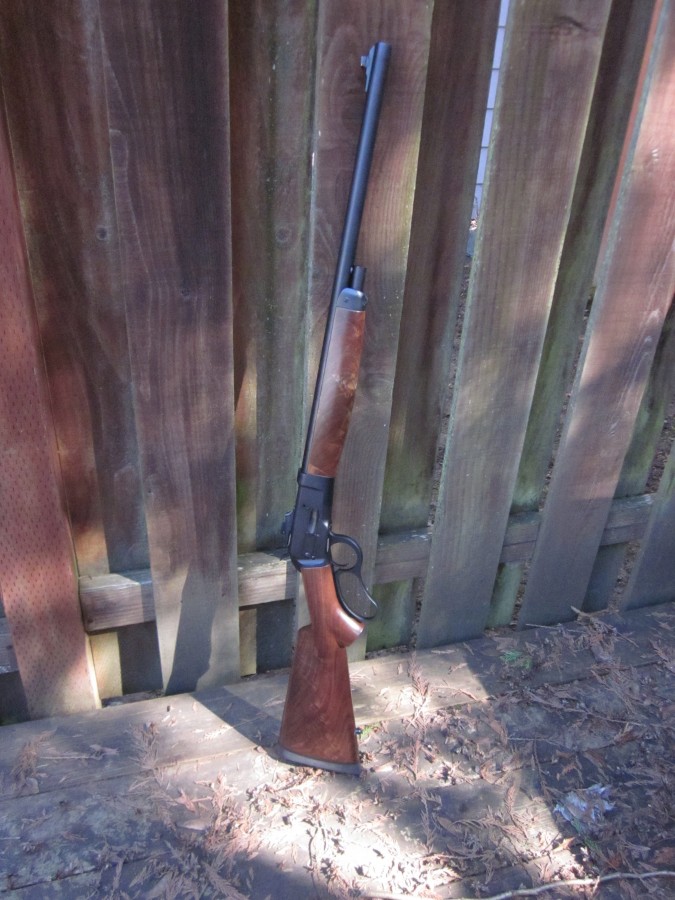
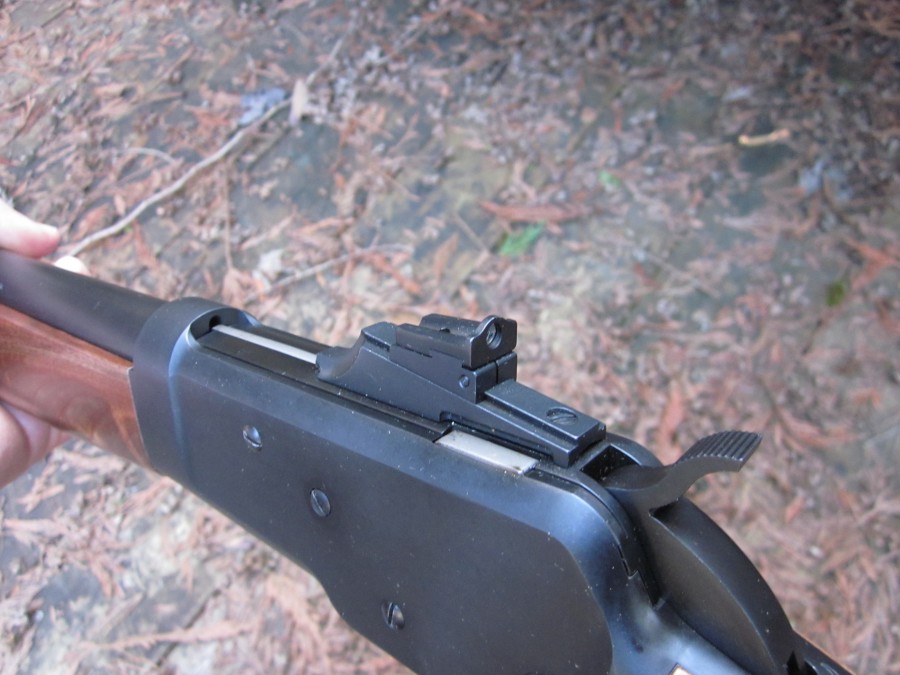
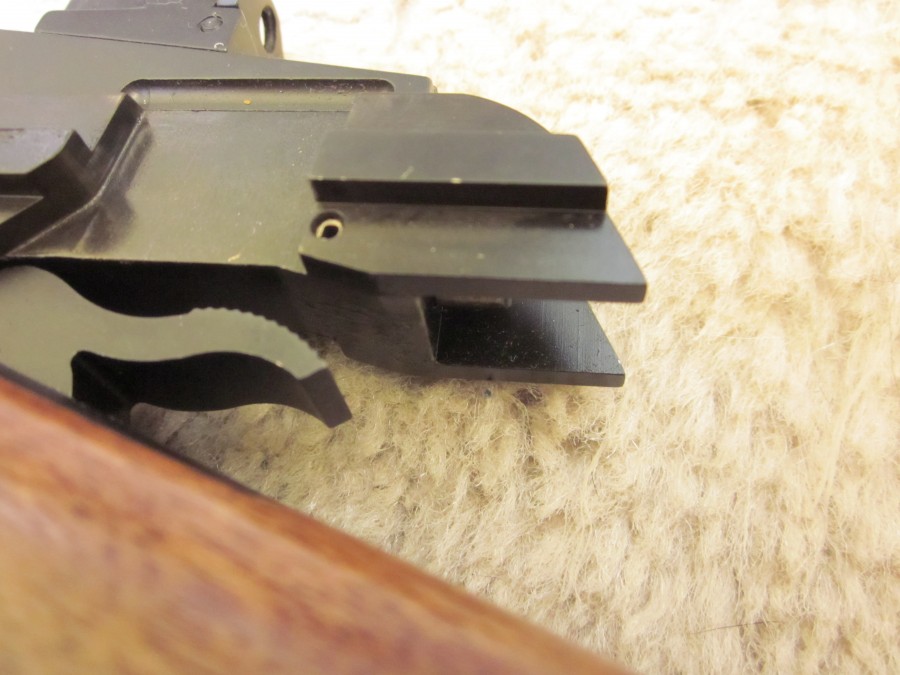

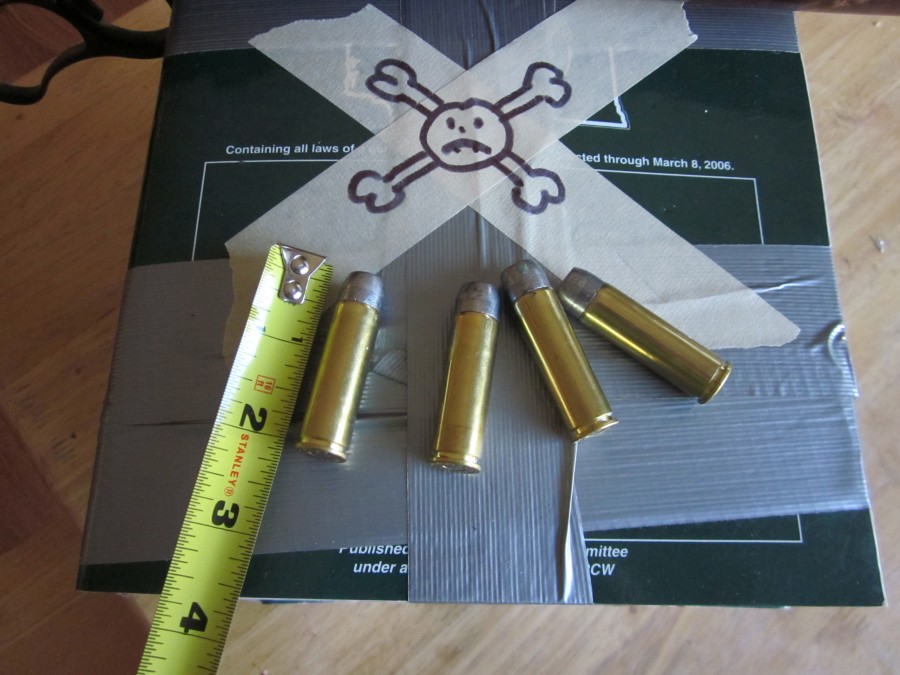



I have wanted such a winchester clone for my entire life! I am haveing a seizure!
YES, YES, YES!!!!
THIS.
Good googley-moogley…drool…
First Evolution reference I’ve seen here. Great rifle, but between the cost of the rifle and the ammo I couldn’t justify it for a range toy. I live in the bay area of San Fran. With the exception of some pols I haven’t seen a dinosaur here in years.
And this my friends is why the 1895 Marlin Guide Gun in 45/70 is such a blast. 1/5 the price (used – never buy new) and very easy to reload and cast bullets cheaply.
Glad you used the chrony….kinda put the armchair ballistics experts in your earlier, teaser post in their place. The schmuck saying 500 s&w was sub 30/06 in particular.
+1 on the 45/70. My thoughts exactly as I was reading this review.
Great review. Having said that, if I was going to get a big bore lever action AND wanted to pay that kind of money, I would get one from Wild West Guns in a take down 45/70 Alaskan or the one that also shoots 45/70 on crack – forgot what that caliber is.
TTAG are big fans of Wild West Guns. My WWG-customized 1894C in .357 Magnum isn’t the most powerful rifle in my collection, but it is absolutely the most cool.
I agree. The .500 in a lever gun is definitely cool, but side ejection is still the way to go with a lever gun. My new 1895 XLR works like a champ with everything from Hornady LeverEvolution to Buffalo Bore. A .460 Smith out of a lever would be very cool as well. Any feeding issues isn’t worth it in a $2500 dangerous game gun.
Great review! It made me want to get one of these rifles and prepare for the dino apocalypse. BTW, do we need to put dinos down with head shots, or will heart-lung shots do the job?
Considering dino brain size, I’d go for the lung shot.
You should really consider the typical profile-presentation for a dinosaur. You’re going to need to penetrate much less tissue to get to the brain.
Just aim one inch above the uvula in the back of the mouth and fire as quickly as you can.
HB, reminds me of a story I heard as a youth. A polar bear was causing problems around a native settlement in Alaska. It was killed by wardens who then took it apart in an attempt to find out why it was behaving this way. Lodged in one of its back teeth was a slug from a .22. The officials speculated that for the slug to have gotten there the bear would have had to been standing on its hind legs and mouth open over the shooter.
.22 lr was in common usage for seal hunting in those days. It was not unusual for a hunter to go missing and never be found on the ice in those days.
jwm, as a point of interest and I may very well be wrong but I remember reading the Inuit were fond of the .22 Hornet as well.
I am familiar with native seal and walrus hunting and have never heard of a .22 LR being used. Mostly they would use a 12 gauge with buckshot or the ubiquitous .222. Some villages that had access to the National Guard armory would use M-16s although this practice was halted after a photograph of a couple of people drawing down on walrus with M-16s was published in Alaska Magazine.
I have lots of walrus tusks (legally registered with NMFS) in my house that I found washed up on the beach, testimony of the ineffectiveness of the .222 and .223 on the largest game animal in North America.
First, what a gorgeous rifle. The fat magazine tube balances nicely with the fat barrel. I have a weakness for stainless lever actions.
Second, $10 to anyone who can “Double Tap” 400 grain S&W .500’s out of, well, anything.
Third, What’s a rifle review doing on TTAG?
I love my .500. Fun as hell. Sure it was expensive, and basically useless since I don’t hunt. It never fails to put a smile on my face though. 🙂
It looks like a fun little lever action, and I’ve always been a big fan of pistol cartridges in carbines. But let’s be clear, 500S&W was designed and optimized as a pistol round.
I love the color of having some fun with the knock-down power of rounds like this, but the assertion that you could take big game, or even large game with this setup is really, well, like taking deer with 5.56. It’s just not the appropriate cartridge unless you’re 25 feet away. Most states won’t let you hunt deer with that .223 varmint round for a reason.
Depending on the loading, muzzle energy of .500S&W is at best about on par with the middle range of .375H&H. Not all African countries have muzzle energy requirements for game, but some do. Those that do have .375H&H as an entry level minimum round energy-wise for killing big game reliably. Especially at any kind of distance. Are you really gonna trust some marginal handgun round against a charging cape buffalo, rhino, or elephant? Hope your guide doesn’t miss on the back-up shot, he’ll be carrying a reliable powerful rifle caliber.
.458 Win Mag, .458 Lott, .460 Weatherby Mag – those cartridges are actually designed for rifles and for big game. .460 Weatherby Mag launches around 8000 ftlbs and still carries more energy at 200 yards than that 500 S&W has at the muzzle. Even compared to those over-pressure rounds that were used to make 500S&W seem far more impressive than it really is.
Want a ‘cool new round’ to use on real big game? Try .408 CheyTac or even .416 Barret. The bullets are kinda light and the velocities a bit high, but at least they’re rifle cartridges and carry some energy. 500 S&W in a carbine? Deer at under 200 yards.
AS a person that takes elk as close as 15 yards and has seen the net results of Griz attacks on bird hunters in ID and MT I would never regret packing this rifle
Don’t get me wrong, I’d rather have it than nothing in bear country. But if I’m hunting in bear country, there’s a .458 Win Mag with us.
I took a 900lb bison with one shot at 90 yards. Check out the Big Horn Armory’s trophy room, there is four bison and a nice elk all taken with the Model 89.
Bison are considered “large game” and Elk are considered “medium game” – neither is even in the ballpark of “big game”. Let alone dangerous game.
People took hundreds of thousands of Bison at 300+ yards with .45-70. So what? Oft times they suffered and wandered for hours, no one cared back then. Is that your position?
I can kill a deer at short range, or a pig at point blank with a .22 LR, that doesn’t make it a quality kill. Just makes it something that happened. Mainly by luck.
Well if the ballistics published are true out of the 22″ barrel I would have no problem using the gun on cape buffalo. My .458 WM has accounted for a few cape buffalo and one elephant, all one shot kills. All the cape buffalo were well under 50 yard shots, one 10 yards and closing. I don’t see any problem using this .500 S&W assuming the stated figures are correct at those ranges. Really you don’t shoot dangerous game at long range. That defeats the whole purpose of the hunt.
Your earlier assertion talking about a .460 Weatherby is… well ridiculous. I have never ever met anyone that used that cartridge. It is a joke. It is way overpowered and virtually no one can shoot it. Yeah, I suppose you can. To tell the truth most people have trouble shooting a .458 WM well. I know I do without lots of practice. I know a few people that have wounded cape buffalo with a .458 Lott (which is really a .458 Watts) I think because they couldn’t handle the recoil.
It is WAY better to use a gun that you can shoot well than some cannon you flinch using. I don’t know about this .500 S&W having no experience with it but I wouldn’t dismiss it. I think it is more for bear protection in Alaska and maybe elk hunting in the PNW both of which entail short distance shots. It is interesting anyway. I would feel just fine walking a Peninsula brown bear out of camp with one. Of course I would prefer my .458 because of its proven record in taking down game and pushing pesky bears out of camp.
Maybe you have more experience than I do.
Jim B. Good info about the Cape buffalo and elephant with the .458 Winchester Magnum. I’ve actually shot the .458, never at a live target, and find it to be hell on wheels.
My question is not about the muzzle velocity or energy of the .500 S&W, but the penetration. Will that pistol bullet, a big one for sure, hold up in a large and heavily built animal such as you’ve hunted?
Well to tell the truth I wondered about that. The bullet being lighter and larger it would stand to reason it would not penetrate as well…but bullet technology has changed so much in the last few years that I would have to say I don’t know. Not for certain anyway. My guess, given the data reported, is that it would work fine.
Really, all the stories one hears about bullet proof cape buffalo are due to poor bullet placement. I have no doubt about that. I know people that have dropped them with one shot with a 30-06 and even a .270. I know personally of one very reported story of where the hunter was gored and I know it was not due to not enough gun but rather poor bullet placement. Well the gun was a .458 Lott. If that isn’t enough for what essentially is a damn cow what is?
I won’t be taking this Model 89 rifle to Africa though. I don’t know, a lever action just doesn’t seem “right” for there. Well at least to me. Yeah, I know TR used one but still it doesn’t seem right. It is an interesting rifle and cartridge combination though. It would be a good rifle for elk in the rain forest of the PNW but I will stick with my .375 for that. There is always a chance of a long shot but to tell the truth I have never had one.
As far as the .458 goes, you are right. It is hell on wheels. The first time I shot mine I was convinced that something had gone wrong. I checked to see if my fingers were still there! Mind you I was used to shooting a .375 H&H with hot loads but this was in another realm of recoil. I learned quickly that his is not a rifle you shoot from the bench. Standing only. Maybe sitting if need be. Brakes do not help much with this caliber because of the size of the bore and the weight of the bullet. They help a little but not like on say a .300 WM.
I really believe anyone can get used to the recoil and shoot it well IF they put the time into it. That is the key. But also remember if you jump up to a Lott which all the gun writers are pushing you have 10% more velocity which translates into 20% more recoil–approximately. Most people cannot stand that. Me include. Really, a .458 WM is my limit to shoot accurately and I admit it.
I can get a 500 grain bullet to travel 2236 fps out out my .458 WM. There is nothing that walks the earth that cannot be stopped by that. I see no need for anything more no matter what some gun writer says.
This gets my gun lust going in a big way 🙁 And I can’t remotely afford it.
I visited the Big Horn Armory machine shop a few years ago while these guns were still in development. We talked tooling and I got to handle a few of the prototypes. They’re a great bunch of guys who are obviously shooters themselves.
I love to see a small shop producing an interesting and original product – not just another AR clone.
I’m going to need one of these rifles to add to my 500 collection. I’m dying to try out the 600 and 700 grain T-REX ammo in a rifle.
It’s an awesom gun. I am the proud owner of number 3. Took a Sitka Black Tail on Kodiak with it this fall. Love it
Lucky bastard! Send us a photo at [email protected]!
i have a S&W 500 Magnum pistol with a 2″ barrel, looks like a huge bellygun. i’d rather fire it with full power loads than a .44Mag. it’s a handful, and flame comes out the short barrel.
i got the dies and it’s still a lot cheaper to reload this round. i’ve got hot loads with 325gr. Hornady rounds and downloaded some with 350gr hardcast LSW.
it gets people’s attention when i touch it off.
I like BIg Horn Armory Model 89!!! I have it own..POWER!!
I have had one of these on order for some time now. I happened to be in Cody today and visited them – and they let me shoot 7 rounds through an 89 carbine. This gun is amazing. I was shooting 500gr Hornady rounds and the recoil was very manageable. This isn’t a just a “back of collection conversation piece.” I’m looking forward to days at the range and hunting with one of my own… someday.
Mine arrived yesterday – I haven’t had a chance to shoot it yet. It is highly customized – to the tune of being a $3K+ hand crafted bespoke version of the BHA 89 carbine. Matt stainless finish. Carbine barrel. Rifle 5 round tube. Scope. Sights upgrade. Scope mount + hardware to not have it mounted. Threaded with JP recoil eliminator brake dialed in and indexed before barrel finishing – looks like it was meant to be there. Don’t blame BHA – that brake was my idea – and they did it perfect. That big brake sitting out there on the end of the barrel – almost like a set of ram horns.
First impressions – wow! Frankly, it’s hard to describe how perfectly this gun combines machine and beauty. That Walnut they use has incredible depth and color. Looking at it under the lights at my local FFL when I picked it up I could see green hues. Under halogens – reds pop out. Everything fits -perfectly-. I have a half dozen .500 S&W snap caps that I’ve cycled through it a few times. Like most lever guns, you need to use the lever with some authority. No feed errors.
My intent here isn’t to create a review, but to assure everyone that this gun is real. They do exist. They are shipping. They are no longer unobtanium mythical constructs. I have one right here.
Worth the wait? It made the guys at the gun shop giddy – and they’re a bunch of Glock & AR fans. I haven’t shot mine yet – ammo just arrived this evening. So far though, wow. It’s hard to talk through this goofy ear to ear grin.
From the comments a lot of you don’t understand why someone would pay enough $$$$ to buy 4-6 firearms for a single gun. It’s OK if you don’t understand. At the moment it’s all about this gigantic grin I get every time I look at this gun. It screams art meets science meets craftsmanship.
Now I need to find some outdoor range time to see what the machine side of this shoulder fired cannon does against evil zombies drawn on cheap paper stapled to cardboard strung from a post at 50 & 100 & 200 yards. Then put the scout scope on and do it again + 300 yards.
I have a mod. 89 carbine. And it is a very nice rifle. I took a Sitka black tail deer with it last year on kodiak island. With a 500gr hornaday at 1,930fps at 60 yards. It worked very well:) my rifle is ser# BHA0003. Do you know how many they have out right now. I got mine fall before last
They’re all the way out into the BHA00160+ range now.
I took mine out and shot 50 rounds through it today using the iron sights. That large rear peep sight is huge – could almost use a tiny 2nd hoop or bead inside the ring. Since mounting the scout scope to it has always been ‘in the plan’ I’m not to worried about it.
So – what did I send through it? It wasn’t so much a matter of ‘choice’ as it was ‘what can I find?’ My original plan had been to stock up on Hornady 500gr rounds just like the ones I shot through BHA’s gun when I visited. No luck. Hornady 500gr rounds are actually harder to find now than 22LR. So, after I found out my BHA 89 was nearly done, I found that the best ammunition I was able to source in short order was Magtech – which turned out to be pretty good.
In order to test through a few different rounds to figure out what I would like shooting, I bought a box each of 325gr SJSP, 400gr SJSP and 275gr SCHP. For those suffering acronym hell, SJSP is Semi Jacketed Soft Point. SCHP is Solid Copper Hollow Point. None are pointy – all flat nosed. They all fed well. That SCHP round may seem out of place with the 89. I wanted to try those out as a possible deer load – no lead in the carcass. So far I like them. In .500 S&W the bullet is large enough that even without lead AND a hollow point it’s still heavy enough and traveling fast enough to get the job done and then some.
Now to get that scout scope mounted. I don’t have the eye for iron sights. The gun is, as usual, more accurate than I am.
The 89 is a thing of beauty and it functions as well as it looks. It took a long time for me to receive it but it was worth the wait. I chose the carbine in stainless with maple furniture and I wouldnt change a thing. It produces about 300 fps greater velocity out of a given load over my 6.5 inch Smith from the custom shop. There is no perceivable difference in recoil between my 89 and my Marlin GBL in 45-70. I enjoy my GBL but there are few things more enjoyable to me than going into the bush around my little area out of Fairbanks with the same ammo in the long gun and in the hog leg. Im all about leaving the half inch hole.
I would like one of these, but also would like it in a longer barrel– 22 Inch or 24 inch.
But then, I am partial to long barrels.
Dunno why. *shrug*
I’d reload with a slower powder if it was a point of diminishing returns. But I like the idea of having both a sidearm and a rifle with the same ammo.
Has any one else had a hard time getting an ETA on the arrival of their rifle. I ordered both the Model 89 and 90 eleven months ago. I was told in April there were about 85 guns ahead of me. Last week(9/25/15) I was told there is about 100 ahead mine. Has anyone else had this problem?
Awesome POST! Are your guys on https://AuctionArmory.com yet? I found a firearms like that in there marketplace differently worth looking into https://auctionarmory.com/product-category/firearms/
Firearm Social Network Auction Armory
To each their own. Long story short…. I personally know a Alaskan guide and his gun of choice for protection, retrieving wounded brown bear in the willows, (that a client had shot) always was a 12 gauge slug. A pump 12 gauge shotgun is way cheaper and does the quickest job! Hype, hype, hype sell the product, but if someone has to have one well good for them. Good luck if you fall down when that bear is charging you and that lever action is at 90 degrees sideways (as your next live round falls out of the action when cycling the next round ) you just became bear bait. Wait this is the real world ha ha ha sorry to wake someone up!!!
Slim Fit Leather Jackets is an online store that sells jackets for men and women with free shipping all over the world! Visit Our Site and Get Your Favorite Actors or Actresses Outfits now at the best prices.